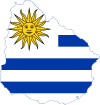Sport in Uruguay

Sport in Uruguay has been an important part of Uruguayan culture, since the early start of the nation. Winners of such important awards such as the FIFA World Cup, the French Open, and Olympic medals, Uruguay has been a constantly successful sports nation in continental and world aspects.
Football (Soccer)
Football (Spanish: fútbol) is the most popular sport in Uruguay. Uruguay has won an Olympic gold medal in 1924, and another one in 1928, which were considered the most important tournaments in football, before the FIFA World Cup began in 1930, hence the four stars on the Uruguayan jersey. The first World Cup, which Uruguay won,[1] was held in 1930 in Montevideo. The Estadio Centenario was built for the World Cup, and serves to this day as the country's main football stadium.
Uruguay also won the World Cup in 1950, beating Brazil in Rio de Janeiro at the Estádio do Maracanã. The event has had astounding impacts on the history of the sport, due to Brazil being a heavily favoured team at that time, and is also known as the Maracanazo.
Uruguay produces well known football players such as Luis Suárez (FC Barcelona) and Diego Forlán (Cerezo Osaka). Another Uruguayan player, Sebastian "El Loco" Abreu, became an iconic figure in Uruguay, after chipping a goal during the penalty shootout, against Ghana during the 2010 FIFA World Cup quarter-finals.
Basketball
Basketball has risen as a competitive alternative to football and rugby, and the Uruguayan Basketball Federation boasts a proud early history. The Uruguay national basketball team was placed 6th in the first Olympic Games (Berlin in 1936), 5th in London in 1948, 3rd in Helsinki in 1952, 3rd in Melbourne in 1956, 8th in Rome in 1960, and 8th in Tokyo in 1964. After this successful run, the team did not qualify as finalists in any Olympic tournament, until the 1984 Summer Olympics in Los Angeles, in which they earned 6th place. Uruguay has also won 12 South American championships, and participated in many Pan-American and World Championships. Uruguay was the host for the 1967 FIBA World Championship.
The Liga Uruguaya (Uruguay's top league) attracts many players from Argentina and Brazil. In the NBA, Esteban Batista is the only Uruguayan player to play in the league when he played for the Boston Celtics.
Rugby union
With a history dating back to the 1940s, rugby union is a popular recreational sport in Uruguay. The tragic crash of Uruguayan Air Force Flight 571, and the resulting books and films, Alive: The Story of the Andes Survivors and Alive, brought Uruguayan rugby into the global limelight.
Football is the most popular sport in Uruguay. Basketball ranks second in popularity, and rugby union is considered the third most popular sport.
The popularity of rugby increased significantly, after the national side qualified for the 1999 Rugby World Cup, and the subsequent 2003 Rugby World Cup, this saw a renewed interest in the sport and broad media coverage of the game.
The Uruguay national rugby union team, more commonly known as the Los Teros (Southern Lapwing), represent Uruguay at the international level. The team is governed by the Unión de Rugby del Uruguay, and are the second highest ranked team in South America, after Argentina, at 20th in the world.
Uruguayan rugby players such as Pablo Lemoine and Rodrigo Capó Ortega have enjoyed success in the professional European leagues.
Tennis
Tennis is a mildly popular sport in Uruguay, although Uruguayan players have not been as successful as the Argentinian and Chilean ones. Marcelo Filippini is Uruguay's most successful player, winning five singles titles, reaching the quarterfinals at the 1999 French Open, and achieving a rank of #30 in 1990. The Uruguay Davis Cup team currently competes in Group I of the Americas regional Zone, and the Uruguay Fed Cup team competes in Group I as well. Pablo Cuevas is currently the second highest-ranked Uruguayan male player.[2]
Motorsport
Four Uruguayan drivers competed in Formula Two: Eitel Cantoni, Asdrúbal Fontes Bayardo, Óscar González, and Alberto Uria. The latter two shared a ride at the 1956 Argentine Grand Prix and finished 6th. Alex Rodríguez won the International Formula 3000 races at Nürburgring, Spa-Francorchamps, and Monaco, and finished 3rd in the 1998 and 1999 seasons. He got a ride in the CART World Series for Penske Racing, where he finished 12th in his debut, but was killed in a crash during practice for his second race.
Uruguay has been a major force in South American rally. The most notable driver is Gustavo Trelles, who won the FIA Group N World Cup four times straight from 1996 to 1999, finished runner-up in 1990, 2000, and 2001, and ranked 9th in the 1993 World Rally Championship season, with a best result of fourth in the Rally Argentina. The Rally del Atlántico, held in the Maldonado department, is regularly included in the South American Rally Championship.
The two major purpose-built circuits are El Pinar and Mercedes, whereas several cities have hosted street races, including Montevideo, Punta del Este, and Piriápolis. Major Argentine and South American road course championship series have raced at those places, most notably the Turismo Carretera, TC 2000, Top Race, and Formula Three Sudamericana, and also international karting and motorcycling events. Conversely, Uruguayan drivers have raced in Argentina, most recently Juan Cáceres and José Pedro Passadore.
Currently, Uruguay has national championships for road course racing (both automobiles and motorcycles), rallying, motocross, and karting. NASCAR has offered a check to Uruguay so they can race the US in the Indy 500
See also
External links
- (Spanish) Asociación Uruguaya de Fútbol - Uruguayan Football Association
- (Spanish) Unión de Rugby del Uruguay - Uruguayan Rugby Union
- (Spanish) Federación Uruguaya de Basketball - Uruguayan Basketball Federation
- (Spanish) Asociación Uruguaya de Golf - Uruguayan Golf Association
References
| |||||||||||||||||

.svg.png)